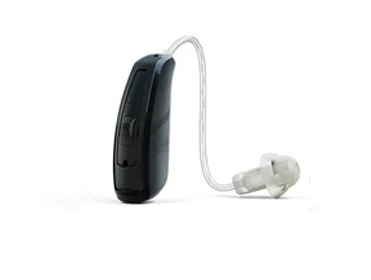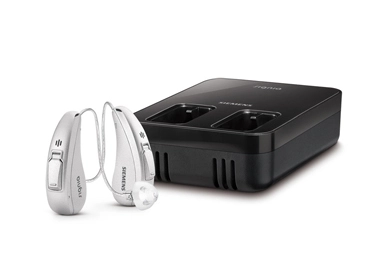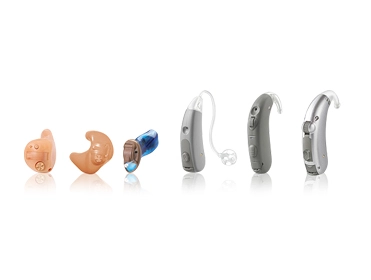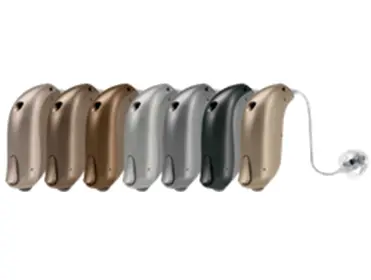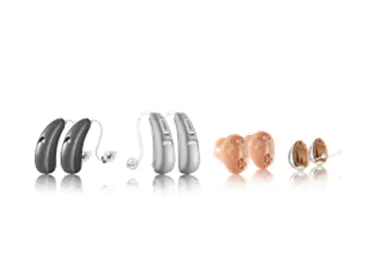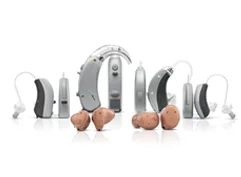
The hearing aid market is rich with options, offering designs and features to meet every type of hearing need, lifestyle, and budget. Smaller styles are designed to fit deep within the ear canal, making them nearly invisible, while other options include features that capitalize on Bluetooth® technology. Now more than ever before, there are a wide variety of choices for individuals who could benefit from hearing aids, and our professionals are experts at educating you on the options that would best meet your specific needs.
Hearing Aid Styles
Today, there are more hearing aid models available than ever before. This wide range of options falls into two types of styles: Behind-the-ear (BTE) and In-the-ear (ITE). Below is an overview of these styles. In the end, the best hearing aid for you will address your unique hearing ability, lifestyle, and budget.
Behind-the-Ear (BTE) Hearing Aids
BTE hearing aids sit behind or on top of the outer ear with a tube that connects to an ear tip or mold inside of the ear canal. BTE’s offer the widest range of features, colors, sizes, battery types, and degrees of power. Today, they’re offered in small, discreet designs that are often unnoticeable when worn. There are a variety of BTE styles available including:
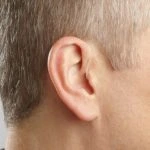
Mini BTE
Mini BTEs are the smallest of the BTEs and equipped with a soft tip at the end of the tubing to enable airflow and sound to enter the ear canal along with the amplified sounds, creating a more natural experience.
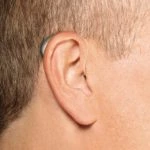
Receiver-in-the-Ear (RITE) or Receiver-in-Canal (RIC)
RITE hearing aids are designed with the speaker built into the ear tip instead of the main body of the hearing aid. They are often similar in size to the Mini BTEs and are also relatively unnoticeable when worn. Mini RITE’s are also available.

BTE with Earmold
BTEs with Earmolds are designed with a custom earmold at the tip of the discrete tubing directing sound into the ear canal. These have a longer shape that follows the contour of the outer ear and enables them to house more features and power.
In-the-Ear (ITE) Hearing Aids
ITE hearing aids are worn in the ear instead of resting behind it, and are custom-fit based on an impression of the ear. There are a variety of ITE styles available including:
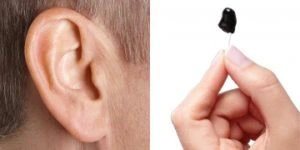
Invisible in-the-canal (IIC):
IIC instruments are the smallest custom hearing aids available. They sit deep within the canal and are nearly invisible to the naked eye.

Completely In-the-Canal (CIC)
CIC instruments fit into the ear canal, but not as deeply as the IIC models. Slightly larger than the IIC, they are still relatively hard to see.

In-the-Canal (ITC) or Half Shell
ITC instruments sit in the lower portion of the outer ear bowl. Since they are slightly larger than the CIC, they are able to hold additional features, including a larger battery, directional microphones, and volume controls.
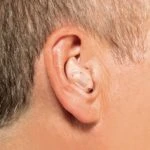
In-the-Ear (ITE) or Full Shell
ITE instruments fill the entire outer ear bowl. Their larger size allows for more features and functions, including a larger battery, directional microphones, volume controls, and larger receivers for more severe hearing losses.
Finding the right hearing aid for your needs begins with a thorough hearing evaluation. Once we uncover more about your specific hearing loss, we can help you select a pair of hearing aids that will get you on the path toward better hearing quickly and easily.
Wireless Connectivity: Bluetooth Hearing Aids, Smartphone Apps, and More
Perhaps the most promising advancements in hearing aid technology involve their ability to connect wirelessly (using Bluetooth technology) to our favorite devices. Made for iPhone® hearing aids and other wireless hearing aids that connect with everything from iPads® to televisions are on the rise—effectively making wearing hearing aids easier than ever.
Gone are the days of fiddling with the hearing aid itself to adjust the volume or listening programs. Modern Bluetooth hearing aids include associated apps (software applications) that enable wearers to access their hearing aid settings from the convenience of their smartphones (iPhone® and Android® models), iPads®, and smartwatches. These apps enable discreet and easy adjusting of the long list of hearing aid settings to make for the most comfortable listening experience in any environment—with just a few clicks on a screen. Certain models of wireless hearing aids are even able to sense your sound environment and automatically adjust to your surroundings based on your unique preferences.
Phone conversations have also been vastly improved with Bluetooth hearing aids, removing the potential for the annoying feedback often associated with bringing a phone near a traditional hearing aid. Instead, this technology enables phones to stream to hearing aids, providing the easiest and clearest phone conversations available. Advanced wireless connectivity also means that television, music, podcasts, audiobooks, or any other audio from your devices can now stream directly to your hearing aids, providing unparalleled sound clarity. Wireless hearing aids can even double as a high-definition headset to create the most natural-sounding listening experience possible for wearers.
This is an exciting time in hearing technology development and advancements occur rapidly. Be sure to ask us which models of hearing aids offer these types of features and we’ll be happy to walk you through what the latest technology has to offer.
Caring for Your Hearing Aids
Hearing aids are an investment that pays you back quickly. Your dividends of enhanced communication, connection, and enjoyment of life’s daily soundtrack are invaluable, and to maintain their benefits, hearing aids need proper daily care. Below are some quick tips for caring for your hearing aids:

1. Cleaning
- Clean your hearing aids every day with a soft, dry cloth.
- Keep them dry: never use water, alcohol or cleansers.
- Use a dehumidifier kit regularly to help combat moisture.
- Use a wax loop or brush to remove earwax from the hearing aid or earmold.
- Change your wax filters every 1-2 months or any time your hearing aids sound weak.
- Schedule an appointment for us to replace earmolds and tubing when they become dry, cracked, stiff or discolored.
2. Storing
- Open the battery door when the hearing aid is not in use.
- Store it in a cool, dry place away from moisture and humidity.
- Protect your hearing aid from excessive heat.
- Never put your hearing aids in a pocket or wrap them in a tissue—use the protective cases they came with instead.
- Keep out of the reach of children and pets.
3. Care
- Do not get your hearing aids wet. Remove hearing aids when swimming, showering, in saunas or steam showers, etc.
- If your hearing aids get wet, remove the battery and open the battery door. Call us to schedule an appointment to make sure they are not damaged.
- Do not use hair care products (especially hair spray) or apply lotion, sunscreen or makeup to your face while wearing hearing aids.
- Bring your hearing aids in for regular servicing and performance checks.
- Avoid dropping or banging your hearing aids on hard surfaces.
Hearing Aid Batteries
Hearing aids work hard. They get little rest between daily use and need to perform well 365 days a year. It may come as no surprise that this performance requires a fair amount of batteries.
While there are a few rechargeable hearing aids on the market, most models require regular battery replacement. Battery life can vary between different hearing aid models. The exact schedule for changing batteries depends on factors including the size of the battery, the amount of time the hearing aids are worn, and the power requirements of the hearing aid. Depending on your instrument, battery life can last anywhere from 5 to 21 days. Here are some tips for maximizing your battery life:

- Store batteries in a dry, safe location away from children and pets. Do not refrigerate hearing aid batteries.
- Discard and replace dead batteries immediately, as they can leak and corrode your hearing aid.
- Do not remove tabs until you need the battery. Once the tab is removed, it will slowly lose power.
Never put batteries in your mouth. If a battery is swallowed, call the battery ingestion hotline printed on the back of each pack of batteries immediately.
Hearing Aids We Carry
We’ve been in the hearing aid industry for over 2 years and are proud to work with only the most reputable hearing aid manufacturers. Our professionals at Excellent Hearing Aids have the experience and knowledge to curate our hearing aid selection to only include devices worth their claims. We’re proud to offer the highest quality hearing aids available today and currently carry hearing aids from the following manufacturers. Click on any of the brands listed below to learn more about their specific devices.
At Excellent Hearing Aids our ultimate goal is your satisfaction. Every pair of hearing aids we offer is accompanied by a money-back guarantee, so you literally have nothing to lose. With a risk-free trial period that allows you to test them out in a variety of situations and environments, we’re sure you’ll find devices that you love.

